
Bozzoni, F.; Bonì, R.; Conca, D.; Meisina, C.; Lai, C.G.; Zuccolo, E.
A Geospatial Approach for Mapping the Earthquake-Induced Liquefaction Risk at the European Scale. Geosciences 2021, 11, 32.
Published: 8 January 2021
Abstract
This paper presents a geospatial methodology for zoning the earthquake-induced soil liquefaction risk at a continental scale and set-up in a Geographic Information System (GIS) environment by coupling data-driven and knowledge-driven approaches. It is worth mentioning that liquefaction is a phenomenon of soil instability occurring at a very local spatial scale; thus, the mega-zonation of liquefaction risk at a continental scale is a hard facing challenge. Since the risk from natural disasters is the convolution of hazard, vulnerability, and exposure, the liquefaction risk mapping is based on the combination of geospatial explanatory variables, available at the continental scale, of the previously listed three assumed independent random variables. First, by applying a prediction model calibrated for Europe, the probability of liquefaction is mapped for the whole continent. Then, the Analytical Hierarchy Process (AHP) is adopted to identify areas that have a high risk of liquefaction, taking into account proxy data for exposure. The maps are computed for different levels of severity of ground shaking specified by three return periods (i.e., 475, 975, and 2475 years). A broad variety of stakeholders would benefit from the outcomes of this study, such as civil protection organizations, insurance and re-insurance companies, and infrastructure operators.
KEYWORDS:
liquefaction; earthquake; GIS; hazard; exposure; risk; geospatial; zonation; machine learning; Europe
This is an Open Access article distributed under the terms of the Creative Commons Attribution License (http://creativecommons.org/licenses/by/4.0/), which permits unrestricted use, distribution, and reproduction in any medium, provided the original work is properly cited.